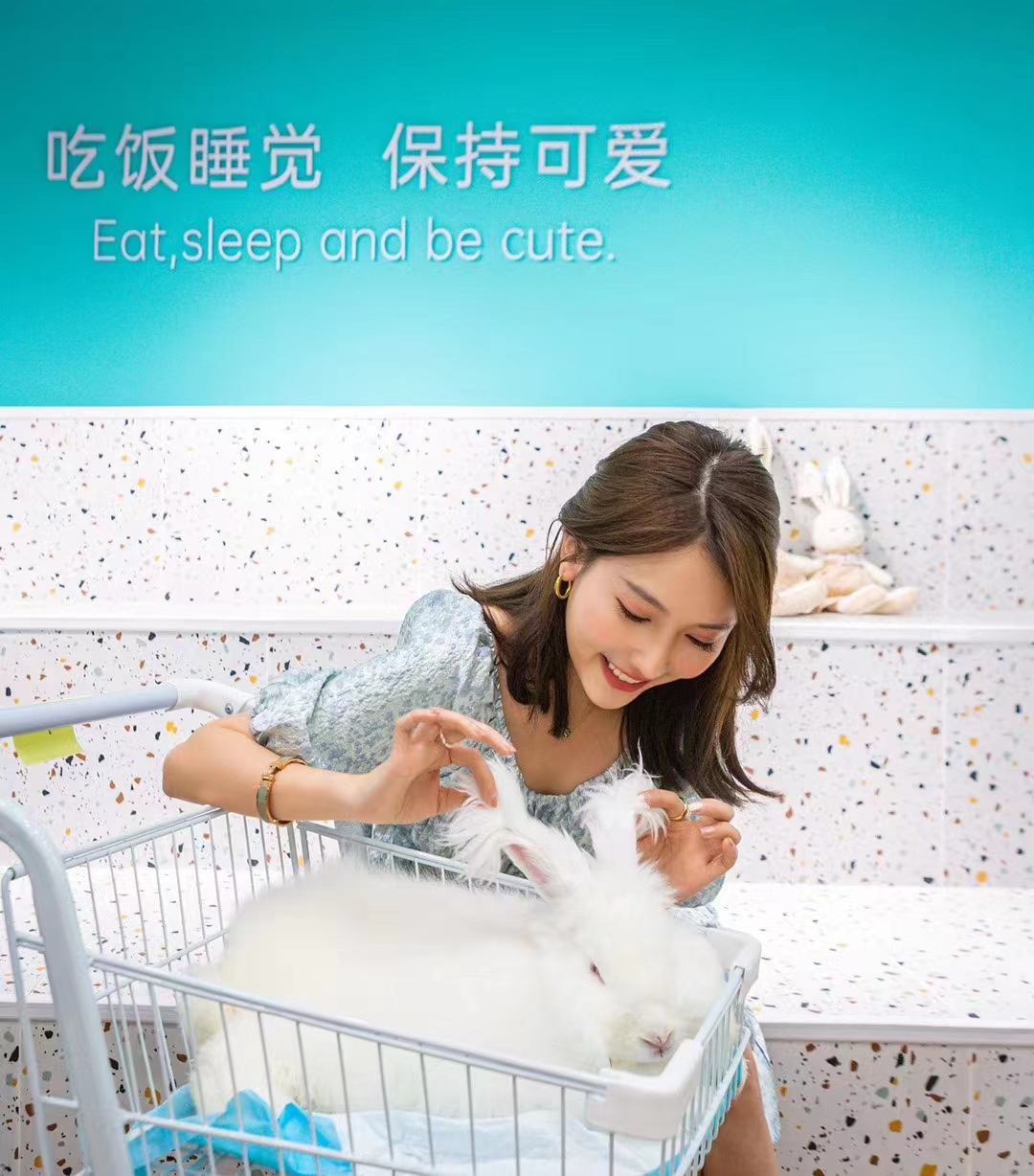

蒙阴长毛兔:如何给长毛兔采毛?
 发布日期:2024-05-13
来源:http://www.myxinhua.com 发布人:创始人
发布日期:2024-05-13
来源:http://www.myxinhua.com 发布人:创始人
如何给长毛兔采毛?
How to pluck hair from a long haired rabbit?
采毛是长毛兔饲养过程中的成果收获,合理的采毛方法不仅可促进兔毛生长,而且可明显提高兔毛质量。
Hair picking is a result of the breeding process of long haired rabbits. Reasonable hair picking methods can not only promote the growth of rabbit hair, but also significantly improve the quality of rabbit hair.
1.梳毛梳毛的目的是防止兔毛缠结,提高兔毛质量,也是一种积少成多收集兔毛的方法。
1. The purpose of combing is to prevent rabbit hair from getting tangled, improve the quality of rabbit hair, and is also a method of collecting rabbit hair by accumulating small amounts.
(1)梳毛次数梳毛是养好长毛兔的一项经常性管理工作。一般仔兔断奶后即应开始梳毛,此后每隔10~15天梳理1次。凡被毛稀疏、排列松散、凌乱的个体容易结块,需经常梳理;被毛密度大、毛丛结构明显,排列紧密的个体被毛不易缠结,梳毛次数可适当减少。所以,饲养良种长毛兔,增加被毛密度,是防止兔毛缠结、减少梳毛次数的有力措施。
(1) Combing frequency is a regular management task for raising long haired rabbits. After weaning, young rabbits should start combing their hair, and then comb every 10-15 days. Individuals with sparse, loosely arranged, and disorderly fur are prone to clumping and require frequent grooming; Individuals with high hair density and a clear structure of hair clusters are less prone to tangled hair, and the frequency of combing can be appropriately reduced. Therefore, raising high-quality long haired rabbits and increasing the density of their fur is a powerful measure to prevent tangled rabbit hair and reduce the frequency of grooming.
(2)梳毛方法梳毛一般采用金属梳或木梳。梳毛顺序是先颈后及两肩,再梳背部、体侧、臀部、尾部及后肢,然后提起颈部皮肤梳理前胸、腹部、大腿两侧,整理额、颊及耳毛。遇到结块毛时,可先用手指慢慢撕开后再梳理,如果确难撕开时,即可剪除结块毛。
(2) The combing method generally uses metal or wood combs to comb hair. The combing sequence is to first comb the neck and then the shoulders, then comb the back, body side, buttocks, tail, and hind limbs, then lift the skin of the neck to comb the chest, abdomen, and thighs on both sides, and finally sort the hair on the forehead, cheeks, and ears. When encountering clumped hair, you can slowly tear it open with your fingers before combing it out. If it is difficult to tear it open, you can cut off the clumped hair.
(3)注意事项梳毛是一项细致而费时的工作,特别是被毛稀疏、容易结块的长毛兔应坚持定期梳毛。长毛兔的皮肤较薄,尤其是靠近尾根周围的皮肤更薄,要防止撕裂皮肤。梳毛时应由上而下,右手持梳自顺毛方向插入,朝逆毛方向托起梳子。
(3) Notes: Combing hair is a meticulous and time-consuming task, especially for long haired rabbits with sparse fur and easy clumping. Regular combing should be maintained. The skin of long haired rabbits is thinner, especially around the tail root, to prevent tearing of the skin. When combing hair, it should be done from top to bottom, with the right hand holding the comb and inserting it in the direction of the hair, and lifting the comb in the direction of the hair.
2.剪毛剪毛是采毛的主要方法。对于新养长毛兔的户,可以找有经验的养兔户或者技术熟练、剪毛工具新潮的“代客剪毛站”,专人剪毛。

2. Scissoring is the main method of picking hair. For households that have newly raised long haired rabbits, they can find experienced rabbit owners or skilled and trendy "proxy shearing stations" with dedicated personnel for shearing.
(1)剪毛次数以年剪毛4~5次为宜。根据兔毛生长规律,养毛期为90天者可获得特级毛,70~80天者可获得一级毛,60天者可获得二级毛。为满足长毛兔喜欢冬暖夏凉的习性,年剪5次的剪毛时间可分别安排在3月上旬(养毛期80天)、5月中旬(养毛期70天)、7月下旬(养毛期60天)、10月上旬(养毛期80天)和12月中旬(养毛期70天)。
(1) The recommended frequency of shearing is 4-5 times per year. According to the growth pattern of rabbit hair, those who have been raised for 90 days can obtain special grade hair, those who have been raised for 70-80 days can obtain first grade hair, and those who have been raised for 60 days can obtain second grade hair. To meet the habit of long haired rabbits that prefer warm winters and cool summers, the shearing time of 5 times a year can be arranged in early March (80 days for raising wool), mid May (70 days for raising wool), late July (60 days for raising wool), early October (80 days for raising wool), and mid December (70 days for raising wool).
(2)剪毛方法剪毛一般采用专用剪毛剪,也可用理发剪或裁衣剪.技术熟练的剪毛员,每5~10分钟可剪完1只兔子。剪毛顺序为背部中线一体侧一臀部一颈部一颌下一腹部一四肢一头部。将剪下的兔毛应按长度、色泽及优劣程度分别装箱,毛丝方向一致。
(2) The shearing method generally uses specialized shearing scissors, which can also be used as hair clippers or clothing clippers. A skilled shearing worker can cut one rabbit every 5-10 minutes. The order of shearing is the midline of the back, one side, one buttocks, one neck, one jaw, one abdomen, four limbs, and one head. The cut rabbit hair should be packed separately according to length, color, and quality, and the direction of the hair should be consistent.
(3)注意事项
(3) Precautions
,剪毛时剪子应贴紧皮肤,切忌提起兔毛剪,特别是皮肤皱褶处,以免剪破凸起的皮肤。
Firstly, when shearing, the scissors should be tightly attached to the skin and avoid lifting the rabbit hair scissors, especially at the wrinkles of the skin, to avoid cutting through the protruding skin.
第二,防剪二刀毛(重剪毛)。如一刀剪下后留茬过高,不可修剪,以免因短毛而影响兔毛质量。
Secondly, prevent double shearing (heavy shearing). If the stubble is too high after being cut with one knife, it should not be trimmed to avoid affecting the quality of rabbit hair due to short hair.
第三,剪腹部毛时要特别注意,切不可剪破母兔的乳头和公兔的阴囊,接近分娩母兔可暂不剪胸毛和腹毛。
Thirdly, special attention should be paid when cutting abdominal hair, and the nipples of the mother rabbit and the scrotum of the male rabbit should not be cut. Chest and abdominal hair should not be cut temporarily when approaching the mother rabbit during childbirth.
第四,剪毛宜选择在晴天、无风时进行,特别是冬季剪毛后要注意防寒保温,兔笼内应铺垫干草,以防感冒。
Fourthly, shearing should be done on sunny and windless days, especially in winter. After shearing, attention should be paid to cold and insulation, and hay should be laid inside the rabbit cage to prevent catching a cold.
第五,患有疥癣、霉菌病及其他传染病的兔子,应单独剪毛,工具专用,防止疾病传播。凡有剪破皮肤者应用碘酊,以防细菌感染。
Fifthly, rabbits suffering from scabies, mycosis, and other infectious diseases should be sheared separately with specialized tools to prevent the spread of the disease. Anyone with cut skin should be disinfected with iodine tincture to prevent bacterial infection.
本文来自:蒙阴长毛兔 更多的内容请点击:http://www.myxinhua.com 我们将会为您提问的问题提供一个满意的服务,欢迎您的来电!
This article comes from: Mengyin Changmao Rabbit. For more information, please click: http://www.myxinhua.com We will provide satisfactory service for the questions you ask. Welcome to call us!